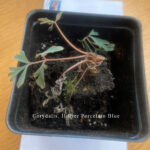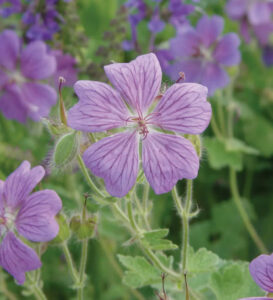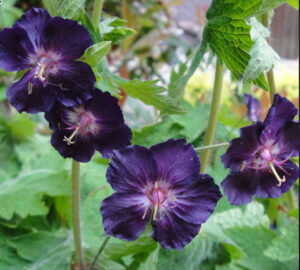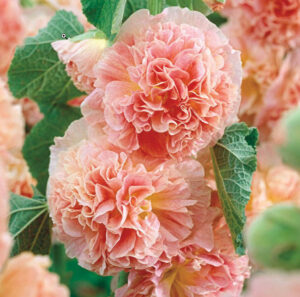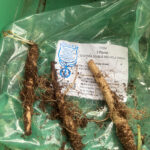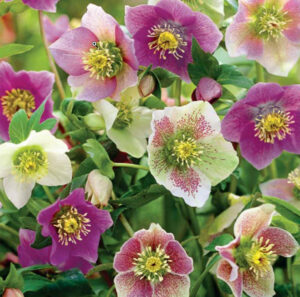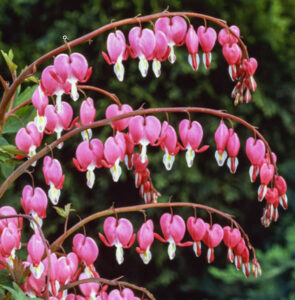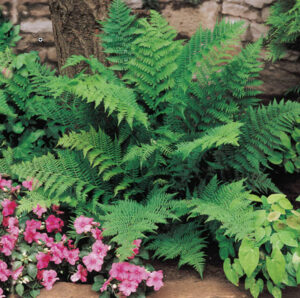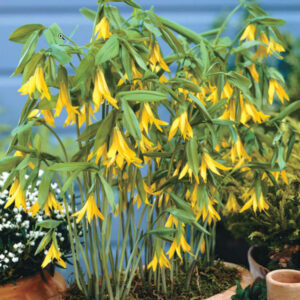|
Corydalis, 3½” bunches of delicate hanging blue bells are hardy and strong. And the bells don’t need chill to chime: no cold period necessary for fantastic summer blooms.
A shade-loving perennial originating in woodland and mountainous areas of China. Growing to 30 cm, in spring it produces masses of bright blue tubular flowers with a white throat. It is summer dormant, meaning that the foliage dies down in summer. It produces flowers for the majority of the year, typically only falling dormant in late winter. It has a sweet honey-like scent, attractive, soft blue-green foliage and bears flowering stems of a delicate light-to-mid blue. This Corydalis thrives in a number of situations, from full sun to partial shade, and sits perfectly in beds and borders. It will tolerate most soil types, although doesn’t like particularly wet or dry soil. Water regularly, being conscious that it will not enjoy being waterlogged or in excessively dry conditions. |
|
Rozanne Geranium is a hybrid clump-forming geranium series with excellent heat tolerance and showy violet-blue flowers that appear in late spring. They tolerate full sun or partial shade, though flower best in full sun. Established plants show some drought tolerance and plants are also resistant to browsing by deer and rabbits. Raven Geranium phaeum blooms first in May and then reblooms later in the summer, staying colorful all the way into August. The broad, flat blooms make an extremely impressive display when viewed head-on. ‘Raven’ is easy, resistant to drought and the ravages of slugs and rabbits. The only fauna it attracts are bees and other pollinators (read “butterflies”). It swiftly grows to its mature height of 18 to 24 inches tall and wide. Fantastic for patio and containers in the South and Southwest, where many geraniums have short and unsatisfactory bloom seasons. ‘Raven’ displays a remarkable bloom time. Intensely colored 1-inch blooms of nearly-black purple with a white eye begin appearing on this graceful plant in early summer, and keep coming until early fall. The reblooming display can stretch from May through until August. This hardy geranium is very easy to grow: just plant it in average, well-drained soil and it does the rest. Space 18 inches apart. Give ‘Raven’ some shade in hot and dry climates. Bareroot |
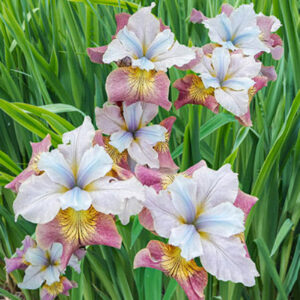
Siberian Iris Sugar Rush. 3 bare roMature Spread : 18 – 24 inches
Spacing: 18 – 24 inches
Growing Tips
Planting Instructions : Loosen soil well before planting. Plant with the eyes just below the soil. Dig a hole large enough to accommodate the roots without bending them. Space plants 18-24″ apart. Firm soil around roots and water well. Soil Moisture : Prefers moist soils, but will do also well in regular garden soil with average moisture. Will Tolerate : Acidic Soil, Clay Soil, Loamy Soil, Wet Soil, Sandy Soil. Pruning Instructions : Remove spent flowers for a clean look. Winter Care : Mulch +/- 2″. Planting Depth :Plant with the eyes just below soil level. Watering Requirements :Average water needs. Do not over water. Fertilization Requirements :Once per year. DutchBulbs.
Hollyhocks: How to grow bare root Hollyhocks:
A great “barnyard” plant—Hollyhock and Hardy Garden Phlox are similarly heavy feeders in full sun—it should be planted in great drifts for stunning washes of color, as well as in the cutting garden. Tubers from Breck’s Giant beauty towering, flowering plant is perfect for adding visual interest behind other, smaller perennials. Butterflies, hummingbirds and bees can’t resist. Delicately crinkled, scarlet, 3–5″ blooms. Drought tolerant and unappetizing to deer. Excellent as a cut flower. Performs best in rich, moist, well-drained soil. Alcea roseaBotanical NameAlcea rosea ‘Chater’s Double’. Form: Perennial, Hardiness Zone3-8, Flowering Time: Summer to fall
|
|
Fluffy double blooms in a gorgeous colour. Produces plenty of lush, peach-pink blooms that grow freely up stalks that reach up to 7′ tall. Peaches ‘n Dreams brightens up borders, makes dynamic floral arrangements and perennializes like a dream. The plant is easy and quick to grow, drought tolerant and deer resistant. It naturalizes readily and returns yearly with increased vigour and bloom. |
|
Deep maroon blooms that look almost black grow singly—and quickly—on tall, stiff spikes. Large, rough, heart-shaped lower leaves become progressively smaller toward the top of the spire. Alcae rosea ‘Nigra’Botanical NameAlcea rosea ‘Nigra’ |
|
HARDY GLOXINIA: Fern like foliage with un-fern like blooms. Incarvillea delavayi do best in full sun in well-drained soil and appreciate an autumn mulch. Clumps can be divided in early spring taking care not to damage the main tap roots. Looks best when grown in clumps of three or five plants for maximum effect. If you are planting dry roots or crowns rather than pot grown plants they need to be inserted 3-4in deep into the ground. Slugs can be a problem with the new growth in late spring but they readily grow through the problem. Does best in full sun in well-drained soil and appreciate an autumn mulch. Botanical Name Incarvillea delavayi |
|
These 4″ flowers are nicuble Hellebore Botanical Name:ely set off by attractive foliage that is evergreen in milder climates and semi-evergreen elsewhere. Height/Habit: 24 – 28 inches, Spread: 18 – 24 inches An annual application of manure or compost will help to boost the growth of your hellebores. Provide plenty of water during spring and fall when they are actively growing. You can ease up during the summer because heat causes hellebores to go dormant. Hellebores can be fussy about being dug up and moved, so it’s generally just best to leave them be.
|
|
Michigan Bulb, Helleborus Botanical Name: Flower Form: Cup-shaped, 5-petaled, borne in terminal clusters. |
|
Botanical Name: Dicentra spectabilis Flower Form: Heart-shaped (larger than Dicentra eximia) flowers grow on pendulous racemes to 9″ long. |
|
Red Cardinal Flower Botanical Name: Lobelia cardinalis Flower Form: Terminal spike – irregular. Bracted raceme. Upper lip is split into 2 lobes, & the lower into 3. The fused stamens form a red tube from which the anthers protrude. |
|
Botanical Name: |
|
Create a sun-dappled look in your woodland garden with naturalized drifts of sunny yellow blooms. These little nodding bell-shaped blooms are precious in a wildflower garden. For that beloved big old shade tree that grass doesn’t grow well under, Native Yellow Bellflower is the perfect alternative. As it is a native U.S. plant, originally from Missouri, it is quite adaptable too. It tolerates drought and dry soil particularly well, which is great for one of the toughest planting sites—dry shade. It likes well-drained soil, so rock gardens are also a good place for it. A sweet treat around hostas and trillium. Botanical Name: Uvularia grandiflora Flower Form: 1″ nodding slender flowers |
|
Our Spring 2022 Louisiana Irises are from Sonoran. Beautiful coral pink blooms with soft yellow highlights. One of our favorites. Average Height: 2-3 feet Recommended Water Depth: 0-6 inches Plus 2 collections of LOUISIANA IRIS – ASSORTED MIX (3 Plants) per collection. Iris hybrids. Average Height: 24-36 inches Recommended Water Depth: 0-6 inches Bog Louisiana Irises prefer to grow in either very wet soil or shallow water. Bog and Louisiana Irises are resilient Hardy Bog Plants that will keep blooming year after year. Spring blooming, leaves are evergreen in all but the coldest winter climates (USDA Zone 4-5) Will grow and bloom in any exposure from 3 hours of full sun to all-day sun. Winter hardy down to USDA Zone 4 (unless otherwise noted.) When planted now, Louisiana irises need to be handled carefully to avoid damaging the foliage and flower buds. Louisiana irises should be grown with as much direct sun as possible. At least about six hours of direct sun is needed for good blooming. When preparing a spot to plant Louisiana irises, incorporate a generous 3-inch layer of compost, rotted manure or peat moss and a general purpose fertilizer following label directions. The plants prefer a soil high in fertility and organic matter. They also generally prefer an acid soil, though here in New Orleans where our soils are slightly alkaline they do very well. Aquatic culture is one of the easiest and most natural ways to grow these irises, and the foliage tends to stay more attractive in the summer. Simply place your potted iris into your decorative pond or aquatic garden so that the rim of the pot is a few inches below the water’s surface. Every one to two years, divide and repot them in heavy garden soil. You also can simply plant them into the soil at the edge of a pond, and they will grow along the edge and down into the shallow water. Plant Louisiana irises in beds at the same level they were growing in the container. The rhizome should be at the soil surface. Care must be taken to protect the foliage and flower stalks when planting irises from a container at this time of year. They may be top heavy and unstable when first planted, but do not allow the foliage or bloom spikes to flop over or break. If necessary, place a stake next to the plant and loosely tie it up. Established plants generally do not need to be staked. Providing adequate moisture is an important part of growing Louisiana irises. Keep newly planted irises well-watered, and continue to water during dry weather until late June. After that, as the irises go dormant, watering is less important unless you’re trying to keep the foliage in good shape. Resume watering as needed in late September as the plants come out of dormancy. Fertilize your irises in October and February. Irises growing in containers in aquatic gardens should be fertilized by lifting the pot out of the water and placing aquatic fertilizer tablets below the soil surface. Always keep irises growing in mulched beds. This is an essential part of good culture especially in the summer. A 2- to 3-inch layer of leaves, pine straw or other mulching materials helps prevent sunscald of the rhizomes as well as reducing weeds. So, as soon as all of the flowers have bloomed out, the flower spike should be removed to the point where it emerges from the foliage to prevent seed pod formation. 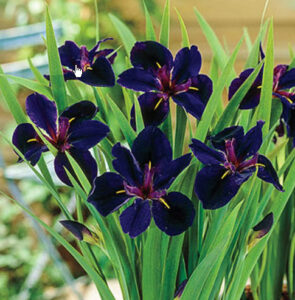 Louisiana Iris Black Gamecock. 3 bare roots. DutchBulbs. Best with about an inch of water each week. Blooms in June-July.  Louisiana Iris Ann Chowning. 3 bare roots. DutchBulbs. Best with about an inch of water each week. Blooms in June-July. Mature Spread : 24 – 30 inches. Spacing: 24 – 30 inches. Planting Instructions : Plant with the eyes just below soil and 24-30″ apart.. |
|
Mature Spread : 18 – 24 inches |


